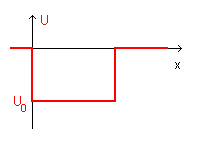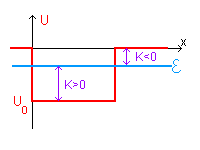
Now we will consider a one-dimensional field in which the potential V is everywhere 0 except on the interval [0;L] where the potential energy of a particle is negative with constant value U0 < 0. Intervals like this are said one-dimensional potential wells with depth U0.

In Classical Mechanics a particle with positions 0<x<L and total energy
![]() lesser than 0 but greater than U0 can not escape from the well because outside it
its kinetic energy K =
lesser than 0 but greater than U0 can not escape from the well because outside it
its kinetic energy K = ![]() -0
would be negative.
-0
would be negative.

The Quantum Mechanics approach is the following:
if 0<x<L the wave function must be a solution of the equation (the subscript I stands for 'Internal')
![]()
if x<0 or x>L the wave function must be a solution of the equation (the subscript E stands for 'External')
![]()
Since the wave function must be continuous and differentiable in the entire field, for x=0 or x= L the two solutions and their derivatives must have the same values.
Moreover, since the Quantum Mechanics approach must asymptotically converge to Classical Mechanics, x→±∞ ⇒ ψ → 0.
With a method similar to that taken in the previous section 8, we assume for the equation (9.1) a solution
![]() and, in the same way we obtain
and, in the same way we obtain
![]()
But in this case, we cannot assume the boundary conditions ψ(0)=0 e ψ(L)=0, because the walls of the pit have finite altitude. So, for now, we have
![]()
Solutions of (9.2) can not be something like
![]() , because the second derivative
implies a negative value to the the square of b.
If we otherwise assume solutions like ψ(x) = a eb x, differentiating twice with respect
to x we have
, because the second derivative
implies a negative value to the the square of b.
If we otherwise assume solutions like ψ(x) = a eb x, differentiating twice with respect
to x we have

and the comparison with (9.2) gives
![]()
This equality is acceptable because, by hypothesis,
![]() is negative.
Therefore outside the well the function may have the form
is negative.
Therefore outside the well the function may have the form
![]()
Since the wave function must be zero for x→±∞, we assume (the subscript EL stands for 'External Left' and the subscript ER stands for 'External Right' )
For x=0 the two solutions and their derivatives must be equal. So

![]()
The same happens for x=L. So

From (9.6) and (9.8) we have

Finally, using the values of c and kI from (9.3) and (9.7), we have

By solving this equation with respect to
![]() for each value of n
we can obtain the energy levels inside the well.
There is no analytical way to calculate thise solutions, but they can be approximated at will with a numerical method
beginning from n=1 and raising it while negative solutions are found.
for each value of n
we can obtain the energy levels inside the well.
There is no analytical way to calculate thise solutions, but they can be approximated at will with a numerical method
beginning from n=1 and raising it while negative solutions are found.
Here there is a Javascript function that calculates energy levels of an electron in a one-dimensional well, given its width, measured in nanometers, and its depth measured in volts.
JS uses the simple bisection algorithm. The code is in the HTML source of this page.